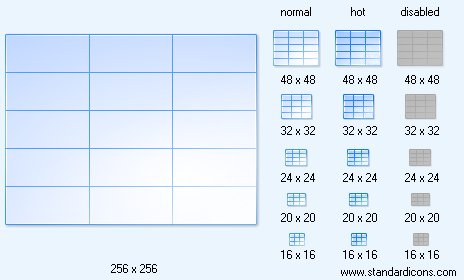


|
| ||||||||
|
|
Table Icon |
|
Icon sizes: 48x48, 32x32, 24x24, 20x20, 16x16, 256x256, 128x128, 64x64, 512x512
File formats: ICO, GIF, PNG, BMP
Making Standard Tab and Menu Icons for Android Apps
When designing Android apps or drawing graphics for mobile apps, one must follow certain guidelines. Using icons designed for different systems, especially desktop-based, is generally not a good idea. Foreign images will look out of place at best, or will render your Android apps appear hardly recognizable at worst.Designing Standard Tab and Menu Icons for Android Apps Description: When developing Android apps or designing graphics for mobile apps, one must conform to srict guidelines. Re-using images made for other operating systems, especially desktop-based, is not a good idea. Foreign graphics will look weird at best, or will make your Android apps appear hardly recognizable at worst. Body: There exist precise guidelines available in reference to Android icons. Different design guidelines are published for tab icons and menu icons.
Tab icons represent individual tabs in tabbed interface. Tab icons should be provided in two different states: selected and unselected. It is recommended that tab icons are drawn as simple, flat shapes as opposed to graphics shown in 3D or isometric projection.
Android OS and Android apps are used on a multitude of hardware platforms employing a wide range of hardware. In connection to icon graphics, those devices can have different screen sizes, screen resolutions, pixel density and dimensions. To accommodate the wide range of displays, Android developers must provide all tab icons used in their apps in at least three resolutions to be shown on low, medium, and high density screens. Resolution-wise, the outer boundaries for the three sizes are defined as 24x24, 32x32, and 48x48 pixels. The size of the shape itself should not exceed 22x22, 28x28, and 42x42 pixels respectively. By supplying all three standard sizes, designers can ensure that their apps will be shown properly on a wide range of devices running the Android OS.
Menu icons are used in the "options" menu, and are displayed to the user when they press the Menu button. Similar to tab icons, menu icons are specified as flat, grayscale images. Like tab icons, developers should not use 3D or isometric projections.
Screen resolutions for menu icons are described in a slightly more complex way as opposed to to tab icons. Instead of two sizes described for tab icons (inner shape and boundary box), the inner shape of menu icons can be smaller or larger depending on whether they are square-shaped or not. If a menu icon is square-shaped, its resolution should be smaller than for icons shaped otherwise. The reason for specifying two different sizes is to establish a consistent visual weight across the two icon types.
The outer dimensions for ldpi, mdpi and hdpi icons are defined as 36x36, 48x48, and 72x72 pixels respectively. Inner shapes for square, low-definition icons should be 22x22 pixels, while non-square icons should fit into a boundary box sized 24x24 pixels. Similarly, medium-definition icons should fit 30x30 and 32x32 pixel boxes, while high-definition images should fit into 44x44 and 48x48 pixel boundaries respectively.
Instead of designing your own graphics matching these guidelines, Android developers have an option of ordering ready-made graphics from professional designers. As an example, Android Tab Icons by Aha-Soft offer 112 unique tab images in both states and all three standard sizes. Should additional resolutions be required, developers can produce icons at any size by opening scalable vector sources. Android Tab Icons can be viewed and downloaded at http://www.aha-soft.com/stock-icons/android-tab-icons.htm.
Copyright © 2009-2022 Aha-Soft. All rights reserved.
|
